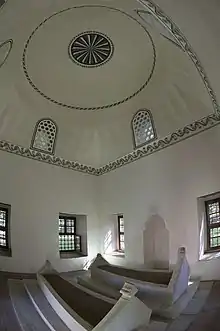Gülşah Hatun
Gülşah Hatun (Ottoman Turkish: کل شاہ خاتون; died c. 1487) was a consort of Sultan Mehmed the Conqueror of the Ottoman Empire.
| Gülşah Hatun | |
|---|---|
 The tomb of Gülşah Hatun is located in Muradiye Complex in Bursa. | |
| Died | c. 1487 Bursa, Ottoman Empire (present day Bursa, Turkey) |
| Burial | |
| Spouse | Mehmed the Conqueror |
| Issue | Şehzade Mustafa |
| Religion | Sunni Islam |
Early years
She married Mehmed in 1449, when he was still a prince and the governor of Manisa. Just before Sultan Murad II's death,[1][2] she gave birth to her only son, Şehzade Mustafa, who was to be his father's favourite.[3][2] According to Turkish tradition, all princes were expected to work as provincial governors as a part of their training. Mustafa was sent to govern Konya and later Kayseri, and Gülşah accompanied him.[4][5]
Mustafa's death
Mustafa died in June 1474 of natural causes.[6] It was rumored that Mustafa had approached Mahmud Pasha's wife and thus making him the person behind Mustafa's murder.[7][2] There are speculations that Gülşah Hatun may have been a party to the illicit relations between the prince and wife of Mahmud Pasha.[8] Giovanni Maria Angiolello, a Venetian traveler, author of an important historical report on the Aq Qoyunlu and early Safavid Persia, who was in the service of Mustafa, and who with the rest of Mustafa's household accompanied the prince's cortege from his post his Kayseri to Bursa, where he was buried, denied any role for Mahmud Pasha in Mustafa's death;[7][9][2] nevertheless Mehmed II had the man executed shortly thereafter.[10]
Gülşah Hatun had not been informed of his death, and with the wagon with her dead son stopped outside the palace, she and the women of her train began to wail. Babinger wrote that Mustafa's only child, Princess Nergiszade, shared her grandmother's grief, and the lamentations went on endlessly.[6] Mehmed sent word that she should remain in Bursa with those maidens whom she required. Mehmed also had a good provision made for her, where she might live there honorably. He ordered that Mustafa's daughter and her mother and rest of the ladies together with all others belonging to the court of his decreased son should come to Istanbul. All the women were lodged in the palace where women of Mehmed's harem stayed, and after several days the maidens were married to courtiers.[9] Nergiszade married her cousin Şehzade Abdullah, eldest son of Şehzade Bayezid (future Bayezid II) in 1480.[11]
Last years and death
In 1479, Gülşah Hatun was granted the village of Sığırcalu in Dimetoka,[12] its revenues were converted into mülk so that Gülşah could turn it into an endowment for the eventual upkeep of her tomb in Bursa.[13] Gülşah Hatun died in 1487, and was buried in Bursa in the tomb she had built for herself near that of Mustafa.[9][3][5] The tomb of Gülşah Hatun has an entrance with elegant jogged voussoirs, and marble cenotaphs inside, newly made from old pieces.[14]
References
- Babinger 1992, p. 61.
- Stavrides 2001, p. 351.
- Uluçay 2011, p. 39.
- Peirce 1993, p. 47.
- Sakaoğlu 2008, p. 129.
- Babinger 1992, p. 330.
- Babinger 1992, p. 331.
- Peirce 1993, p. 299.
- Peirce 1993, p. 50.
- Stavrides 2001, p. 181.
- Al-Tikriti, Nabil Sirri (2004). Şehzade Korkud (ca. 1468-1513) and the Articulation of Early 16th Century Ottoman Religious Identity – Volume 1 and 2. pp. 95, 312 n. 76.
- Archivum 1983, p. 191.
- Zachariadou 1996, p. 33.
- Greenhalgh 2009, p. 475.
Bibliography
- Archivum Ottomanicum, Volume 8. Mouton. 1983.
- Babinger, Franz (1992). Mehmed the Conqueror and His Time. Princeton University Press. ISBN 978-0-691-01078-6.
- Bey, Mehmet Süreyya (1969). Osmanlı devletinde kim kimdi, Volume 1. Küğ Yayını. ISBN 978-9-004-12106-5.
- Greenhalgh, Michael (2009). Marble Past, Monumental Present: Building With Antiquities in the Mediaeval Mediterranean. BRILL. ISBN 978-9-004-17083-4.
- Peirce, Leslie P. (1993). The Imperial Harem: Women and Sovereignty in the Ottoman Empire. Oxford University Press. ISBN 978-0-195-08677-5.
- Sakaoğlu, Necdet (2008). Bu mülkün kadın sultanları: Vâlide sultanlar, hâtunlar, hasekiler, kadınefendiler, sultanefendiler. Oğlak Yayıncılık. ISBN 978-9-753-29623-6.
- Stavrides, Théoharis (2001). The Sultan of Vezirs: The Life and Times of the Ottoman Grand Vezir Mahmud Pasha Angelović (1453-1474). BRILL. ISBN 978-9-004-12106-5.
- Uluçay, M. Çağatay (2011). Padişahların kadınları ve kızları. Türk Tarih Kurumu.
- Zachariadou, Elisavet A. (1996). The Via Egnatia under Ottoman rule (1380-1699): Halcyon Days in Crete II : a symposium held in Rethymnon 9-11 January 1994. Crete University Press.